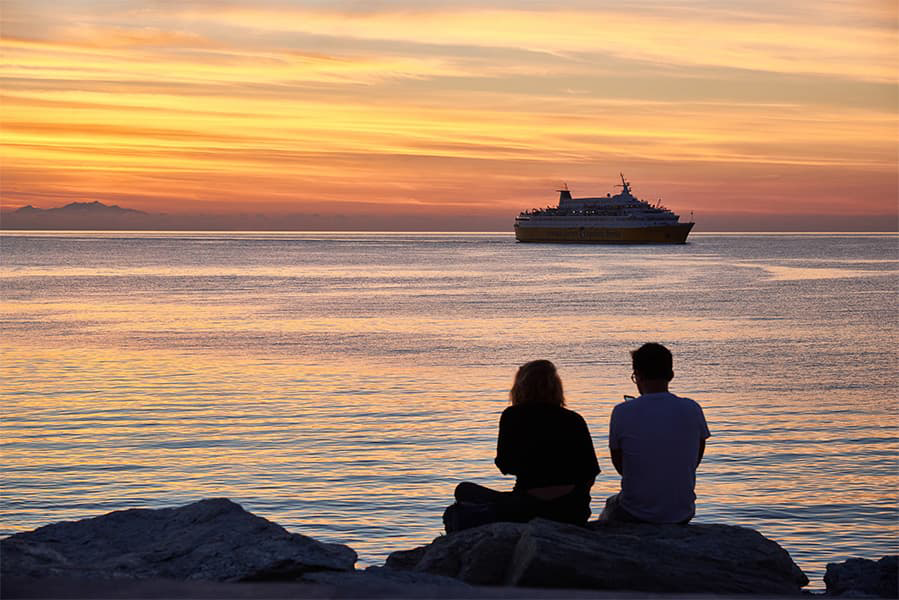Horta – Sao Roque
Ferry to Pico
Horta – Sao Roque
Ferry to Pico

Depending on the season their are about 6 weekly sailings between Horta and Sao Roque.Atlanticoline provides the ferry from Horta to Sao Roque. Horta Sao Roque ferries take around 1 hour 10 minutes. The ferry costs between $54.40 and $186.52, depending on ticket details. Prices exclude any service fees. Ferry timetables change seasonally, use our Deal Finder to get live pricing and availability for ferries from Horta to Sao Roque.
The earliest Horta Sao Roque ferry typically departs Horta at about 07:00 and the last ferry usually leaves at 21:00.
Ferries from Horta to Sao Roque sail in around 1 hour 10 minutes. Ferry duration can vary by ferry provider and can be impacted by weather conditions.
There is 6 weekly sailings from Horta to Sao Roque provided by Atlanticoline. Timetables can change from season to season.
The price of a ferry from Horta to Sao Roque typically range between $54.40* and $186.52*. On average the Horta Sao Roque ferry is $93.96*. The cheapest Horta Sao Roque ferry prices start from $54.40*. The average price for a foot passenger is $55.72*. The average price for a car is $176.69*.
Pricing will vary depending on number of passengers, vehicle type, route and sailing times. Pricing is taken from searches over last 30 days and exclusive of service fees, last updated 1 April 2025.
The distance between Horta to Sao Roque is approximately 21 miles (34km) or 18 nautical miles.
Yes, Horta Sao Roque ferries allow cars onboard with Atlanticoline between Horta and Sao Roque. To view car ferry tickets and prices between Horta and Sao Roque use our Deal Finder.
Atlanticoline allow foot passengers on Horta Sao Roque ferries.
Currently, are not permitted to board ferries from Horta to Sao Roque.
More routes than anyone else.

Compare fares, times & routes in one place.
Change plans easily with flexi tickets.

Book e-tickets & manage trips in-app.
Live ship tracking & real-time updates.

Top-rated customer support when you need it.
Far off the coast of Portugal, almost forgotten in a remote stretch of the North Atlantic Ocean, are a smattering of volcanic islands that form a small archipelago known as the Azores. Found at the western edge of this archipelago is the island of Faial; a grassy expanse of rugged hills that plunge into the crater of the region’s stratovolcano heart. The vibrant port city of Horta is found around a small bay on Faial’s eastern coast. This proud coastal city and its sprawling marina are a renowned stop for vessels voyaging across the Atlantic. It’s rich seafaring history is depicted by the series of painted murals daubed onto the walls of the promenade, each a tribute to the ships that have come to harbour at the port. Found beyond the crenelated wall looming over the coast are the whitewashed buildings of the suburbs that rise in tiers upon the foothills. Between them run narrow roads and walkways, some with origins stretching back to the city’s humble 16th Century beginnings as a farming community. One of the most striking remnants from this era is the Church of Santa Bárbara, its black and white façade a neat blend of modern and historic architecture. The ferry terminal in Horta is found on a pier at the northern end of the bay. It is a relatively small building with a limited amount of facilities including an open plan waiting hall, free Wi-Fi and a small car-park for visiting passengers. Although only a few main road routes circle the island, the region is no more than 13-miles tip to tip and it only takes half an hour to drive to the port from the most distant district of Capelo. A bus regularly also whisks passengers across the island from a stop outside the tourist information centre, just a 20-minute walk from the harbour-side. A multitude of ferries currently leave from the port throughout the week. Lines hosted by Atlanticoline hop across the warm, crystalline surface of the ocean to most of the islands in the Azores archipelago. These include short trips to Sao Roque, Praia de Vitoria, Vila de Praia and Velas, as well as longer voyages to the more distant destinations of Lajes, Vila do Porto and Ponta Delgada.